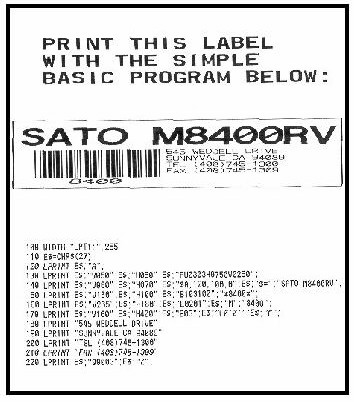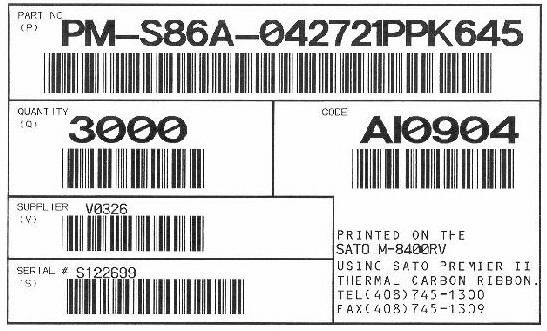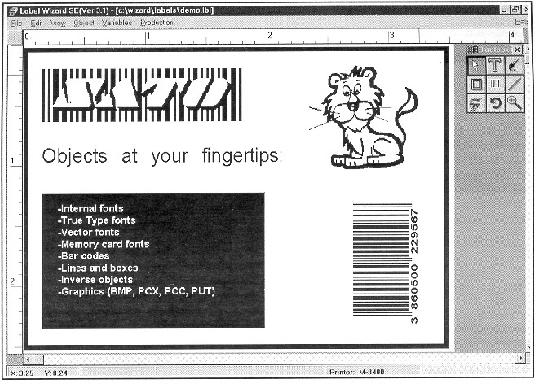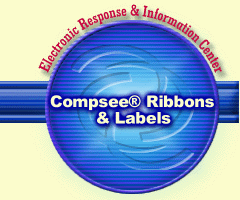Section 4: Label Considerations
Perhaps as important as the type of printer used is
the consideration given to the design and construction of the label
itself. Again, this should be the subject of a specification, especially
if you are expecting someone else to print the label for you. Most
major companies have developed bar code labeling specifications
to which they expect their suppliers to conform. If a shipment is
received without a label or with one that does not meet the specification,
the shipment may be rejected and, worse yet, a fine imposed on the
supplier. A good label specification should, at a minimum, specify
the following information:
- The physical size and construction of the
label.
- The environmental specifications.
- The symbology(s) to be used along with
the technical specifications for the symbol.
- The number, size, position and orientation of the fields along
with the data to be contained in each.
Design
The design of the label is critical. If you are dealing
with a simple item identification label containing nothing but a
single bar code and its human readable information, then it is relatively
simple. However, here you still may be required to make a tradeoff
on whether to print the label horizontally across the label using
a wider web printer or to print it vertically down the length of
the label with a smaller web printer running slower. Complicating
the decision would be the addition of images such as company logos
and fancy human readable printing such as commonly found on retail
bar code tags.
- SIZE
The
physical size of the label must be within reasonable limits. One
too small is difficult for klutzy fingers to position precisely,
while a very large label is almost impossible to apply without
creating a wrinkle (which can destroy the readability of the bar
code). As a general rule, labels as small 1/2' high by 1" long and
as large as 5" high by 7" long can be applied manually without too
much difficulty.
- MULTIPLE BAR CODES
As soon as more than one bar code is included on the label, the
problem of which one is read by the scanner must be addressed.
This can be solved by using different symbologies for each bar
code or by including a "Data Identifier" character at the start
of the data string. The two symbology approach is generally discouraged,
since it requires two symbologies with similar structures and
data encoding capabilities. Another way to separate two different
bar code symbols is to place them at right angles to each other,
but problems appear again when more than two symbols are needed.
Multiple bar code labels must face another problem, that of how
the operator knows which symbol was scanned. This is not difficult
if a hand wand scanner is used, but a moving beam laser operator
has no control over the horizontal scanning of the beam, just
how it is vertically positioned. It is difficult to control which
symbol is being read if they are both placed side by side. In
this case, stacking the symbols vertically, will solve the problem
since the beam can never cut through more than one complete symbol.
All of these problems can be eliminated by use of industry standard
Data Identifiers to identify the data contained in the symbol.
The placement and orientation of the fields
can have a significant effect on the success of a bar code system.
If there is information on the label that must be read by an
operator, then it should be presented in a highly visible area in
a font that will maximize readability. Bar code fields should be
easily identified by the operator who must do the scanning.
- QUIET ZONE
One of the most common mistakes made in label layout is the failure
to Quiet Zones at the beginning and end of the bar code. This
is blank space free of any printing or marks. It is needed by
the decoder to establish the end points of the symbol. While the
decoder may be able to resolve a Quiet Zone that is at least 10
times the smallest bar dimension, the Quiet Zone should never
be less than 0.25". Even at that size, hand scanning with a wand
is difficult because hand motion is very erratic at the beginning
and end of the scan. Placing the bar code too close to the edge
of the label violates the Quiet Zone rule even if the label is
placed on a white surface. The scanner may detect the raised label
edge as a non-reflective bar.

Basic Program and Label
Design Software
After deciding what the label should look like, the
next problem encountered is how to create it. There are two options,
you can either include sufficient write your own program or use
a software package to do it for you. If the number of different
label designs is small, and the data on them is minimal, it is relatively
easy to write a small program to do the job. The Basic program shown
in the illustration will print the example label shown on a SATO
M-8400RV printer. It has only three fields, one a bar code with
HRI information printed below it and two text fields surrounded
by a box. However, the day when the process consisted of sending
a line of characters down to a text printer to be printed upon a
receipt of a carriage return is long gone. Now you have to specify
the font, how large it is, where the characters are to be placed,
the orientation of the field, what type of bar code, etc.
The AIAG shipping label illustrates the problem of
complex label designs. It typically contains 29 fields that must
be separately programmed along with eight border lines. Also, the
information contained in the fields can, and probably will, vary
from label to label. Even if we manage to get all of the fields
programmed correctly, we still have to find a way to easily enter
the variable data into the fields without writing a new program
each time. We are talking serious programming here with "GO TO"
statements, "LOOPS" and other esoteric jargon.
It is obvious that we need something to insulate us
from this process. A label design and software package is in order.
The definition of a "good" label design package depends upon the
label to be designed. For a simple layout, a basic text-based program
asking you to enter coordinates and information with a menu driven
screen is acceptable. However, more complex labels are difficult
to visualize using this method. A WYSIWYG screen layout program
is preferred.
One caveat is in order, even though a label design
program allows you to do all sorts of fancy things, unless the capability
is needed, it can end up complicating your life. The only person
that becomes proficient in using a complicated label design program
is one that uses it a lot. This is not the normal case in the industry,
where it is more likely that a few standard labels will be designed
and used over and over. For this reason, an intuitive design program
is desired, one where you do not spend a lot of time trying to understand
how to use the program. A Windows based program would be a good
choice, since it has a user interface that is familiar to most people.
A Windows design screen from SATO's Label Wizard program illustrates
the advantages. It provides a user-friendly interface that insulates
the user from the intricacies of the design process.

Typical AIAG Shipping Label
A demo copy of Label Wizard can be downloaded free
from the SATO home page on the internet (http://www.satoamerica.com).
This is a complete functional version of the program and contains
all of the features and capabilities of Label Wizard except for
production printing. All of the label formats designed with this
version can be used if a decision is made to upgrade to the full
production version of Label Wizard at a later date.
Printing
Most label design programs will allow you to print labels directly
from the program. Sometimes this is not the way to go. If the operator
only needs to print labels, there is no need to supply access to
the design part of the program. As a matter of fact, it is probably
desirable to limit access since the temptation to "improve" the
design is eliminated. Being able to break the print portion out
into a print only stand-alone program (referred to as a Run Time
program) is the best solution. The operator then has to select the
right label design from a list and identify the source of the data
for the fields.
If the labels are to be used in a production environment,
the ability to automatically access external database files for
the contents of variable fields is a necessity. By defining the
field as a variable and tying it to a database, the information
can be automatically placed in the field at the time of printing.
This allows all database management to be confined to the primary
database and any updates or changes automatically incorporated into
the label without having to modify the label printing job. The database
types can be supported by the program directly or indirectly through
the new Microsoft ODBC (Open Database Connectivity) specification.
- WINDOWS PRINTER DRIVER
Sometimes it is desirable to be able to print
directly to a bar code printer from a standard Windows application
program. To do this you need to load the printer as a standard
Windows printer. A Windows Printer Driver is available for many of
the more popular bar code printers. Windows drivers for SATO
printers are available free of charge from SATO. These drivers
support all of the bar code symbologies resident in the SATO
printers. This allows precise control of the bar code to ensure
that it is printed within specifications.
- USING TrueType� BAR CODE FONTS
Bar codes can be printed from standard Windows applications using
bar code TrueType� fonts, of which a number are available from
different sources. These can be used successfully with the SATO
Windows Printer Driver, but extreme care must be used to ensure
that readable bar codes are printed. There are several areas in
which careful attention must be made:
- Type Size - By design, TrueType� fonts
are scalable fonts. You specify a type size and the computer
generates the best fit using the resolution of the printer. This
works great for human readable fonts, but can cause problems
with bar code fonts. For example, the TrueType� expansion
algorithm tries to make the font outline smooth and decides when
an element is printed with one dot versus going to the next size
by adding another dot. When printing bar code fonts, this can
cause variations in the relative bar widths, resulting in an
unreadable bar code. TrueType bar code fonts are designed to be
printed at specific type sizes using a certain resolution
printer. Using a different type size or a different resolution
printer can destroy the critical bar width relationship of the
bar code.
- Start/Stop and Check Digit Characters
-When data is input for TrueType� fonts, any necessary
start/stop or check digit characters must be included.
- Data Input - Some bar codes support a
number of character sets, many of which are not present on a
typical PC keyboard. The TrueType font must assign some key
combination for these characters.
- Graphics - All TrueType text information is sent in a graphics
format, including bar code symbols. This greatly increases
the transmission time required for each label.

Label Wizard Windows Design Screen
Copyright � 1998
Sato America, Inc.
Return
to Media Index
|



